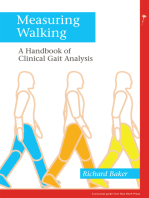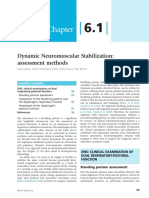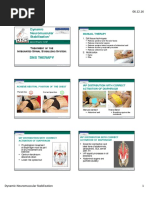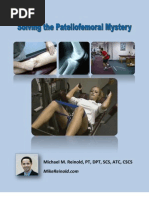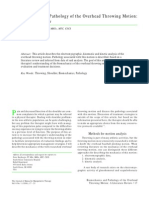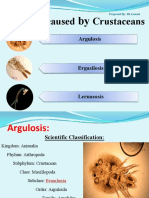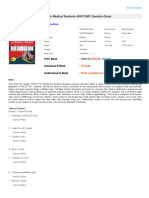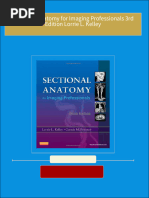DNS Exercise I
Uploaded by
OtrovanjeDNS Exercise I
Uploaded by
Otrovanjewww.rehabps.com 07.04.
15
Who Is the Founder of DNS?
Professor Pavel Kolar, PaedDr.
Director
Rehabilitation Clinic
2nd Medical Faculty
www.rehabps.com Charles University
Prague, Czech Republic
Kolar’s Approach to Dynamic
•! Physiotherapist by training who holds a
Neuromuscular Stabilization doctorate in pediatrics and physiology
!"#$%#&%'()%*Sport and Fitness handouts:
•! Professor of physiology
+#&"*,*
Rehabilitation Clinic
University Hospital Motol •! Head clinician for the Czech Olympic teams
Charles University – soccer, ice hockey, tennis.
Prague, Czech Republic
What is DNS? Sport
•! Sports performance
•! Concept of DNS is based on the scientific
!!Level of physical condition
principles of developmental kinesiology
-! Power/strength/speed
(DK) i.e., the neurophysiological aspects
of the maturing locomotor system. -! Endurance
!!Sport technique
•! It includes both, knowledge and a - Optimal postural foundation
theoretical base, in addition to - Movement quality/coordination
assessment, treatment, exercise and -! Movement awareness
functional strategies.
Dynamic Neuromuscular Stabilization 1
www.rehabps.com 07.04.15
Sport Loading Training
•! Movements with maximum muscle power •! Adequate amount of load to evoke body
adaptation
•! Increased demands on muscular
coordination •! Adequate loading time and repetition
•! Maximum range of motion •! Neuromuscular adaptation
-! Cortical control – process of motor learning (slow
•! Maximum loading on ligaments movements)
and tendons -! Motor programs – learned and fixed programs
•! Increased respiratory demands (cerebellum, basal ganglia pathways)
•! Biochemical and morphological adaptation
40".,/5+)367"8/
Training Posture
-! ./"*)0#1"23*%)4$)%*
•! Should respect anatomy and physiology of the -! 5&6)77)&8*+'22#")98*:2)0#$%)&;;;*
body (local, regional and global anatomical -! <='1=*1/$1)>"*%)4$)9*'%)#2*>/9"?&);*
parameters) -! !"#"$%*'$@/&A#B/$*%)4$)9*'%)#2*
•! Neutral joint position during the entire course of >/9"?&)*C*&'()*+,+-*%.,/0"1",+&2"#3/
movement
-! How to define neutral joint position?
-! Why is it necessary?
Dynamic Neuromuscular Stabilization 2
www.rehabps.com 07.04.15
Development of Postural Postural Foundation
Function
•! Postural function •! Definition of ideal posture
-! Dynamic function -! Foundation of neutral position – established
-! Precedes and follows every movement during motor development
-! Ensures position of the trunk, spine and pelvis
during movement
-! Universal pattern that stabilizes any movement – -! Neutral joint positions
controlled on subcortical level "! enables optimal loading
-! Its quality depends on quality of motor "! ideal balance between agonists and antagonists
development during early childhood "! ideal interplay with other muscles and segments
in the whole system
Neutral (Centrated) Joint
Functional Joint Centration
Positions
•! Dynamic neuromuscular strategy that leads to
optimal joint position that allows for the most
effective mechanical advantage
•! A centrated joint has the greatest interosseous
contact to allow for optimal load transference
across the joint and along the kinetic chain.
•! Allows for maximal muscle pull and protection of
passive structures
Optimal development – in any position, all the
joints are functionally centrated!
Dynamic Neuromuscular Stabilization 3
www.rehabps.com 07.04.15
Functional joint centration Normal (CNS) Development
= Neutral joint position
•! Enables generation fo maximum muscle
power
•! Improves sport performance
•! Ideal/balanced joint loading- decreased load Newborn 3 m/o healthy infant
on ligaments and tendons, prevents cartilage
overuse and degeneration
•! May prevent repetitive strain injury
Normal Muscle Function, Normal Posture
5 months 8 months 9 months
12 months
Program ! Function ! Structural maturation
10 months
CNS Muscle Bone (joint)
Dynamic Neuromuscular Stabilization 4
www.rehabps.com 07.04.15
Developmental Kinesiology Stabilization in a Sagittal Plane
Optimal pattern of core stabilization in 3 m/o infant
1st phase 0 – 4 months and in a weight lifter
sagittal stabilization matures Same muscle coordination; weight lifter just needs
more strength; joint centration same in both
What Causes Spine and Torso Trunk Stabilization
Stability? Liquid ball
phenomenon
•! Intra-abdominal pressure (IAP) is
the main stabilizer of the spine –
this pressure is applied against
the abdominal wall and the
dorsal-lumbar fascia and
supports it.
•! IAP results from ballanced co-
activity of the diaphragm and
trunk and pelvic muscles. INTRA – ABDOMINAL PRESSURE (IAP) REGULATION
Via balanced coordination between the diaphragm, pelvic
floor and abdominal muscles
Dynamic Neuromuscular Stabilization 5
www.rehabps.com 07.04.15
The diaphragm: 3 functions
Respiration
-! Respiration
-! Stabilization
-! Sphincter •! Breathing and stability functions are
always co-dependent.
•! Developmentally important – future
stability
**.#.3+2*%.,,(/7",.3"0/3+/37.#)1"7)6)/.90D*
Muscle Activity during Ventilation Dual Activity of Diaphragm
Muscles of Quiet Inspiration
!!Diaphragm •! Established during ontogenesis (6 months)
1.! Lowering and flattening of the dome, •! Respiratory
increased diameter of vertical thorax
•! Postural
2.! Increased IAP results from
diaphragmatic descend; diaphragm -! contraction and flattening of the D prior to
expands the lower ribs laterally. any movement
3.! Once stabilized by an increased IAP, -! Cause active response of abdominal and
continuing contraction of the costal pelvic floor muscles – ventral spinal
fibers elevates the middle and lower stabilization
ribs (Neumann, 2002).
Dynamic Neuromuscular Stabilization 6
www.rehabps.com 07.04.15
Ideal Respiratory Pattern Rib Movement during Respiration
!!Initial position – relationship
between chest and spine
!!Upper ribs – rotation in CV
joint - chest expansion in
ventral direction
!!Lower ribs – rotation in CV
joint causes expansion in
lateral direction
!!Sternum is stable
!!Movement occurs at SC joint –
if inadequate, AC joint
movement substitutes
Ideal Respiratory Pattern
!!Must be maintained during any dynamic
functional activities and exercises “If breathing it is not normalized –
!!Spinal stability results no other movement pattern can
!!Competition between postural and respiratory
function of the diaphragm - affects the quality of be.”
phasic movement Karel Lewit
!!For example: a tennis player w/weak stabilization
-Unable to maintain postural diaphragmatic
function while playing
!!Yoga trainers usually train abdominal breathing
(ventral protrusion only!) and forget to include the
lateral expansion
Dynamic Neuromuscular Stabilization 7
www.rehabps.com 07.04.15
:3.9*,*;.$+#/<6#%$+#/+</3'"/0*.&'7.-2/.#0/
Respiration and Exercises .90+2*#.,/.#0/&",1*%/26)%,")/
•! Optimal respiratory pattern is essential
for IAP regulation during exercise
•! Strength exercise – expiration while
exerting strength
•! Increased oxygen consumption
reinforces activity of auxiliary
respiratory muscles *#*$.,/ *#%+77"%3/ %+77"%3/
Stabilization Function of the
Diaphragm Open Scissors Syndrome
Optimal position of the chest is essential for
correct diaphragm function
Dynamic Neuromuscular Stabilization 8
www.rehabps.com 07.04.15
Ideal Abnormal
coordination coordination Development of Stabilization
Function
12m
3m 4.5 m 6 -7.5 m 8-9 m 14 -16 m
Physiological Hourglass syndrome
Developmental Kinesiology Global Motor pPatterns
•! 1st phase - 0 – 4.5 months "!Differentiation of extremities’
function
- Sagittal stabilization -! supporting function
•! 2nd phase - from 4.5 months -! stepping forward function
-! Extremity function differentiation within global
patterns "!Ipsilateral patterns - develop
•! 3rd phase - from 8 months from supine
- Development of locomotor function "!Contralateral – develop from
prone
Dynamic Neuromuscular Stabilization 9
www.rehabps.com 07.04.15
IPSILATERAL Global Pattern Ipsilateral Global Pattern
-! Supporting & stepping forward extremities on the
same side (turning, oblique sit)
Stepping forward -
top limbs
Support - bottom
limbs
Ipsilateral Global Pattern CONTRALATERAL Global
Patterns
- supporting & stepping forward function on
opposite sides (reaching for the toy, crawling, walking)
Dynamic Neuromuscular Stabilization 10
www.rehabps.com 07.04.15
Contralateral Global Pattern From contra to ipsilateral pattern
Supporting arm
Stepping forward arm
Supporting phase
changes into
stepping forward Stepping forward
phase phase changes into
supporting phase
Biomechannics of Muscle Work Biomechanics of Muscle Work
PF
"!Concentric muscle contraction – "!If proximal muscle attachment
approximation of two muscle is stabilized (punctum fixum) –
attachments the distal end moves toward
PM
proximal part (punctum mobile)
– PROXIMAL PULL =
"!The direction of muscle pull depends on STEPPING FORWARD
stabilization of the proximal or distal MOVEMENT
attachment, which is provided by other (i.e., limb’s movement in space, swing
phase, open kinematic chain)
muscles (stabilizers).
Dynamic Neuromuscular Stabilization 11
www.rehabps.com 07.04.15
Biomechanics of the Differentiation of Limb Function
muscle work
PM
"!Distal muscle attachment is
fixed = PF
PF
"!Proximal end moves towards
the distal (PM) – DISTAL
PULL = SUPPORTING
FUNCTION !?>>/&B$7*
(stance phase, hand or elbow !")>>'$7*@/&F#&%* *2'AE*
support, close kinematic chain) G9F'$7*>=#9)G*
Exercise Based on Developmental Kinesiology
Developmental Kinesiology Based Exercise
•! Allows training muscles during physiological
function (purposeful movements)
•! Automatically activates an ideal quality of
stabilization function 4m 4.5 m 7.5 m
•! Prevents repetitive strain injuries
•! Performance enhancement
Dynamic Neuromuscular Stabilization 12
www.rehabps.com 07.04.15
Exercises in Developmental Positions Conclusion
Muscles may be strong enough
in its phasic function (anatomic),
but lacking in its postural
(stabilizing) function.
9m 14 m 16 m
Conclusion DNS Tests
Core stability is not defined by
strength of abdominals or back
muscles (or any others), but results
from optimal intra-abdominal
pressure regulation
Dynamic Neuromuscular Stabilization 13
www.rehabps.com 07.04.15
Evaluation of Stabilization Function 1. The Diaphragm Test
a)! Do the joints and segments stay in
neutral position when loaded and during
full ROM?
b)! Which muscles are activated too much
and which are insufficient?
Postural instability – segment or a joint
looses neutral position during postural
loading or movement
The Diaphragm Test The Diaphragm Test
Correct activation
•! Palpate laterally below the lower ribs
•! Symmetrical activation
•! Slightly press against the lateral against the therapist’s
abdominal muscles fingers
•! Check the position and movement of the •! Lower chest expands in a
lower ribs lateral direction
•! Assess : Quality and •! Intercostal spaces widen
symmetry of activation •! Position of the ribs in the
transverse plane remains
the same (ribs should not
elevate!)
Dynamic Neuromuscular Stabilization 14
www.rehabps.com 07.04.15
The Diaphragm Test 2. The Diaphragm Test
Expiratory position of the chest
Insufficient activation
•! None or very weak activation NO !
•! Cranial movement of the ribs –
the patient is unable to
maintain the caudal, expiratory
position of the chest
•! Insufficient widening of the
lower chest and intercostal
spaces poor
stabilization of L spine
•! T spine flexion
3. Intra-Abdominal Pressure Test 3 Months Position
Training (instructions):
•!Caudal (neutral) chest position
•!Diaphragm/pelvic floor
coordination
•!Cylindrical activation of all
abdominal wall sections
Initial position •!Check for neutral neck position
•! Patient supine •!Avoid L spine arching
•! Triple flexion of the legs •!Patient must actively maintain
•! Lower legs supported neutral hip position
•! Hip abduction corresponds to the width of the •!Direct patient‘s breath as far as
shoulders, slight external rotation at the hips – the groin and dorsolateral
centrated position aspects of the abdominal wall
Dynamic Neuromuscular Stabilization 15
www.rehabps.com 07.04.15
Developmental Aspect Posterior Angles of the Ribs
Physiological In newborn: positioned
development 3 months: rib angles behind
Newborn anteriorly to the spine the spine
Structural and functional Normal function and normal
immaturity structural maturation
Man, unlike many
animals, is
immature at birth.
After birth, CNS
maturation occurs
Abnormal development Ideal stabilization
(stabilization) – anterior corresponds with ideal
Individual w/ placement and ”immature”
abnormal early developmental pattern
shape of the ribs remains
development
(1st year of life)
Structural
consequences:
anatomy of a
newborn
Intra-Abdominal Pressure Test Intra-Abdominal Pressure Test
Assessment Correct activation
•! The therapist brings the •! Well balanced
patient’s chest activation of all the
passively into a caudal,
expiratory position parts of the
abdominal wall
•! Then, the support is •! The chest is kept in
slowly and gradually a caudal position
removed from under •! Vertical axis of the
the patient’s legs
diaphragm
•! The patient actively •! The lower chest
holds this position widens
Dynamic Neuromuscular Stabilization 16
www.rehabps.com 07.04.15
Intra-Abdominal Pressure Test:
Ideal model Intra-Abdominal Pressure Test:
Poor activation
•! Activity of upper part of
Ideal activity of rectus abdominis
predominates
(co-contraction):
•! The umbilicus is pulled
in a cranial direction
•! diaphragm
•! abdominal muscles •! Inspiratory position of
•! pelvic floor muscles the chest
•! Concavity of the
abdominal wall above
the level of the groins
Intra-Abdominal Pressure Test
Poor activation
•! None or very little Diastasis
activity of the
dorsolateral parts of
the abdominal wall
•! Hyperactivity of the
paravertebral
muscles
•! Instability
(hyperextension at T/
L junction)
Dynamic Neuromuscular Stabilization 17
www.rehabps.com 07.04.15
4. Trunk and Neck Flexion Test
Hyperactivity of the
rectus abdominis
– upper part
Dynamic Neuromuscular Stabilization 18
www.rehabps.com 07.04.15
Poor Patterns
Trunk and Neck Flexion Test
"! During neck flexion, the
chest is pulled in a cranial
Correct stereotype direction
#!During neck flexion, "! The collar bones are
abdominal muscles become lifted cranially
activated "! Convexity (bulging) at
#!The collar bones do not the lateral aspects of the
elevate (no hyperactivity of abdominal wall
the pectoralis m.) Neck flexion test
#!The chest is kept in a #! Poor stereotype – the ribs
caudal position are not correctly fixed, move in
#!During trunk flexion, a lateral and cranial direction
lateral abdominal muscles
are activated
5. Intra-abdominal Pressure Test:
Sitting Position
Instruction: push against my fingers , increase intra-abdominal
pressure above your groin
Correct pattern:
The umbilicus is not pulled in and up during activation; rather, it
moves caudally
Strong symmetrical activity above the groin (pelvic floor muscles)
Dynamic Neuromuscular Stabilization 19
www.rehabps.com 07.04.15
Poor Patterns
•! Unable to activate lower
abdominals – poor
coordination of trunk
muscles
•! Umbilicus is pulled
inward and up during
activation (hyperactivity
of the upper section of
the rectus abdominis)
•! Frequently associated
with abdominal crease
Insufficient Segmental Movement
Middle T-spine
=>/?76#@/AB3"#)*+#/ •! Insufficiency of the deep neck
flexors: co-activation with
?")3/ extensors
•! C spine hypermobility, (head
extension)
•! Hyperactivity of auxiliary
respiratory muscles
•! Upper scapular stabilizers &
short neck extensors hyperactive
•! Insufficient lower scapular
stabilizers
Dynamic Neuromuscular Stabilization 20
www.rehabps.com 07.04.15
Extension Test:
insufficient pattern 7. Quadruped Rock Forward
o! The upper angles of Performance
the shoulder blades "! The patient
slightly shifts the
are pulled in a cranial head and the
direction (activity of trunk forward
the upper and middle (rock forward)
trapezius), adduction
of the upper angles Assessment
o! Abduction of the "! Hand support
lower angles "! Position of the
scapulae
Quadruped Rock Forward
Evaluate:
•! Support on palms
(tripod)
•! Scapular stability
•! Symmetry of T/L
paraspinals
•! Hypertonus of
upper stabilizers?
Wrong stereotype:
•! Hypothenar hand support (ulnar side of hand)
•! Scapular “winging” (cranial and lateral directions)
•! Hypertonus of PV T/L and upper stabilizers = elevation of
the lower leg
Kapandji, 1974
Dynamic Neuromuscular Stabilization 21
www.rehabps.com 07.04.15
8. The Bear Position
•! Higher & more challenging
position
•! Mistakes are more pronounced
•! Watch the position for
centration of the ankles and
the knees
•! Position of the pelvis, L spine
NO $ •! Position of the scapulae
•! Activation of the laterodorsal
parts of the abdominals
•! Neck centration, head position
YES %
9. The Squat test The Squat test
Correct pattern
•! Neutral pelvic position
•! Good activation of the laterodorsal
sections of the abdominals and
posterior diaphragm
•! Lumbar spine centration – neither
lordosis nor kyphosis
•! Centration of the hip, knee and ankle
joints
•! Correct position of the shoulder
blades - ABD & slight external
rotation
•! Shld, hip and foot should be in 1 line
•! Medial knee should line up between
2nd & 3rd toes
Dynamic Neuromuscular Stabilization 22
www.rehabps.com 07.04.15
The Squat test The Squat Test – Modified
Poor stereotype
•! Hyperactivity of the paraspinal •! If squat with no
muscles (T/L region) support is too
•! Anterior pelvic tilt challenging
•! Decentration of the hip, knee •! Use this modification
or ankle joint •! Modification for both,
•! Shoulder elevation, protraction assessment and
•! Head in forward drawn training
position
DNS Assessment
•! Respiration pattern – test diaphragm in different
positions, during loading, during sport
•! Evaluate and analyse sport technique or
movement
-! joint centration and torso/pelvis axes during the
movement
•! choose 2-3 DNS test - indentify insufficient or
incorrect motor patterns
Dynamic Neuromuscular Stabilization 23
www.rehabps.com 07.04.15
Exercise in Sport and
Sport Technique Evaluation
Fitness Based on DNS
Principles
•! Videotape athlete during
sport activity
•! Pay attention to joint
centration and movement
pattern characteristics
•! Notice any incoordination,
jerky movement, coupled
movement
•! Look for the quality of
relaxation!
DNS Exercise Principles DNS Exercise Principles
•! Correct respiration
•! Optimal sagittal stabilization •! Number of repetitions –
•! All joints and segments in neutral depends on stabilization
(centrated) positions •! Exercise only as long as
the neutral position and
•! Establish a good quality of support good quality of movement
are achieved and
maintained
•! Exercise in static positions
- improve segmental
stabilization function
Dynamic Neuromuscular Stabilization 24
www.rehabps.com 07.04.15
What Position and Load DNS Principles in Athletes
to Start with?
DNS based training
•! Start in posturally easier (lower)
a)! respect ideal posture as defined by
positions (developmentally
developmental kinesiology
younger)
b)! Train variability - adaptation to sport loading
•! Exercise must activate optimal
motor patterns (stabilization, c)! Cortical function training– improve sensory
support, stepping forward) integration
•! Reduce the load if abnormal
position in any segment occurs
Supine with Exercise Ball
Preparatory Exercise with Load 1)! Patient supine, legs flexed
Chest positioning IAP proper activation 2)! Push one hand and contralateral thigh
against the exercise ball
Mistakes:
•! Ball tilts laterally
•! The patient elevates shoulders
•! Increased L lordosis
•! Patient holds her breath
Assist with neutral position of Teach client how to breathe
the rib cage and costal and regulate IAP, to activate
expansion during inspiration “abdominal cylinder” prior to
any movement of the limbs
Dynamic Neuromuscular Stabilization 25
www.rehabps.com 07.04.15
“90-90 Supine“ with T-band Exercises in Supine
•! Supine “90-90 position”
•! Neutral = caudal position of
the ribcage during both,
exhalation and inhalation
•! Hold hands, palms facing up
The T-band is wrapped around the Maintain the basic supine position
shins (just below the knees), crossed with the head, spine, trunk and
from the front to the back side, and •! Extend your elbows as if
pelvis in a neutral position,
brought forward around the thighs (just breathe into the area above the performing a bench press
above the knees), and held in the groin. Supinate your hands while
palms (wrapped twice) with the free performing external rotation at
end of the T-band placed between the shoulders.
•! Use loads for exercise
thumb and index finger. Elbows are progression
flexed 90 degrees.
Exercises in Supine Exercise in Supine with Pulleys
Set up position: supine with legs 90-90 and sagittal
stabilization
•! Supine “90-90 position”
•! Hold weights, bend
elbows and shoulders
while maintaining
caudal position of the
chest, neutral position
of the spine and pelvis
•! Posterior delt, ER, triceps, •! Anterior delt, pecs, obligues
•! Extend elbows as in a •! Supporting arm is in 90 degree
obliques
triceps curl abduction
•! One arm - from 90°flexion
pulls into abduction against •! Stepping forward hand with
pulley resistance pulley in flexion, ER and ABD
pulls to adduction
Dynamic Neuromuscular Stabilization 26
www.rehabps.com 07.04.15
Exercise in Prone
Low Kneeling Exercise
•! Prone position, elbow support •! Sit on your heels
•! Increase intra-abdominal •! Knee distance = shoulder
pressure and load the distance
symphysis (without activity of the
glutes). •! Elbow support, forearms
pronated
•! Depress the shoulder blades
while keeping them apart •! Stabilize the shoulders!
•! Lift your head from mid •! Cue the client to lift his head
thoracic spine and with the C with C spine straight
spine straight. •! Guide the T spine and L
•! 3-6 reps with maximum quality spine straightening while
patient is lifting from his
heels
Quadruped Exercise Quadruped Modification
Horizontal abduction with
Basic position load
•! Centrated quadruped
position
•! Slide one knee back
and forward while
•! Centrated quadruped position •! Use pulley or weight to maintaining the pelvis
•! Spine straight! move one arm horizontal and spine
•! Knees distance = hands •! Joint centration throughout straight
distance the entire ROM
•! hips in 90°, shins and feet •! Direction of moving arm can
converge. vary
Dynamic Neuromuscular Stabilization 27
www.rehabps.com 07.04.15
Quadruped Modification Sitting Exercise
Arm press with optimal
Proper IAP prior to load IAP and centrated pelvis
•! Contralateral arm and leg
support
•! Supporting knee is placed
in front
•! Spine, pelvis, rib cage,
shoulders and supported
hand well centrated at all
times!
•! Stepping forward arm
moves against pulley from First, obtain well balanced IAP & Place legs on the bench in
extension with IR to FL “abdominal cylinder” during: 90-90 position
with ER a)! respiration Knee distance = shld dist.
b)! exercise Balanced IAP first and then
arm press
3M: PRONE
Developmental Positions
3 – 13 months
SUMMARY
Dynamic Neuromuscular Stabilization 28
www.rehabps.com 07.04.15
3M: SUPINE 4M: SUPINE
5M: PRONE 5M: SUPINE
Dynamic Neuromuscular Stabilization 29
www.rehabps.com 07.04.15
5M:SIDE - LYING 6M: SUPINE
6M:PRONE 7M: PRONE
Dynamic Neuromuscular Stabilization 30
www.rehabps.com 07.04.15
7M: 7M: SIDE SITTING - FOREARM
QUADRUPED SUPPORT
8M: SIDE SITTING - HAND 9M: CRAWLING
SUPPORT
Dynamic Neuromuscular Stabilization 31
www.rehabps.com 07.04.15
10M:TRIPOD 10M:
SITTING
10M:ROTATION 11M: BEAR
Dynamic Neuromuscular Stabilization 32
www.rehabps.com 07.04.15
11M: KNEELING
12M: SQUAT
13M: VERTICALIZATION
12M: DEEP SQUAT
Dynamic Neuromuscular Stabilization 33
www.rehabps.com 07.04.15
TRANSITIONS
http://www.rehabps.com/REHABILITATION/Posters.html
www.rehabps.com
DNS principles for athletic
population and training
Dynamic Neuromuscular Stabilization 34
You might also like
- (David Weinstock) NeuroKinetic Therapy An Innovat100% (5)(David Weinstock) NeuroKinetic Therapy An Innovat151 pages
- (David Weinstock) NeuroKinetic Therapy An Innovat100% (3)(David Weinstock) NeuroKinetic Therapy An Innovat151 pages
- Michael Shacklock, M.app - SC, Dip. Physio. (Auth.) - Clinical Neurodynamics. A New System of Musculoskeletal Treatment100% (4)Michael Shacklock, M.app - SC, Dip. Physio. (Auth.) - Clinical Neurodynamics. A New System of Musculoskeletal Treatment255 pages
- The Shoulder: Theory & Practice: Jeremy Lewis50% (2)The Shoulder: Theory & Practice: Jeremy Lewis3 pages
- FMS 2 Corrective Strategies (Online Course)100% (24)FMS 2 Corrective Strategies (Online Course)38 pages
- Dynamic Neuromuscular Stabilization Dynamic Neuromuscular Stabilization100% (3)Dynamic Neuromuscular Stabilization Dynamic Neuromuscular Stabilization25 pages
- The NeuFit Method: Unleash the Power of the Nervous System for Faster Healing and Optimal PerfFrom EverandThe NeuFit Method: Unleash the Power of the Nervous System for Faster Healing and Optimal PerfNo ratings yet
- SFMA Shoulder Corrective Exercises by SportsRehabExpert - Com (C) 2010100% (5)SFMA Shoulder Corrective Exercises by SportsRehabExpert - Com (C) 20109 pages
- Cook and Plisky - Balance, Posture and Movement100% (3)Cook and Plisky - Balance, Posture and Movement57 pages
- Z-Health Master Practitioner 9S:Speed Technique Matters100% (2)Z-Health Master Practitioner 9S:Speed Technique Matters47 pages
- By - Gary Gray, PT - Gray Institute (PDFDrive)100% (1)By - Gary Gray, PT - Gray Institute (PDFDrive)16 pages
- A Guide to Better Movement: The Science and Practice of Moving with More Skill and Less PainFrom EverandA Guide to Better Movement: The Science and Practice of Moving with More Skill and Less Pain5/5 (1)
- Anatomy Syllabus Fall 2015 Sec 0001and HonorsNo ratings yetAnatomy Syllabus Fall 2015 Sec 0001and Honors10 pages
- What Is Dynamic Neuromuscular Stabilization (DNS) ?: How Is The Core Stabilized?No ratings yetWhat Is Dynamic Neuromuscular Stabilization (DNS) ?: How Is The Core Stabilized?5 pages
- Principles of Postural Restoration For The Sports PB Summit100% (1)Principles of Postural Restoration For The Sports PB Summit11 pages
- Overhead Throwing: Biomechanics and Pathology100% (1)Overhead Throwing: Biomechanics and Pathology7 pages
- 4 Stuart McGill Assessing Movement Part One Transcript100% (1)4 Stuart McGill Assessing Movement Part One Transcript12 pages
- Functional Movement Assessment Score SheetNo ratings yetFunctional Movement Assessment Score Sheet1 page
- Preparing Your Patients For The Game of Life and SportNo ratings yetPreparing Your Patients For The Game of Life and Sport24 pages
- Proprioceptive Neuromuscular Facilitation - TECHNIQUES100% (3)Proprioceptive Neuromuscular Facilitation - TECHNIQUES52 pages
- Joanne Elphinston Stability Sport and Performa PDF100% (2)Joanne Elphinston Stability Sport and Performa PDF353 pages
- Fascial Training: With Easy Exercises To More Mobility And Less Pain (10 Minutes Fascia Workout For Home)From EverandFascial Training: With Easy Exercises To More Mobility And Less Pain (10 Minutes Fascia Workout For Home)5/5 (3)
- Improving Ankle and Knee Joint Stability: Proprioceptive Balancefit Discs DrillsFrom EverandImproving Ankle and Knee Joint Stability: Proprioceptive Balancefit Discs DrillsNo ratings yet
- Recent Advances in PhysiotherapyFrom EverandRecent Advances in PhysiotherapyCecily PartridgeNo ratings yet
- (Bloomsbury Library of Educational Thought) Bailey, Richard - Kohler, Richard - Piaget, Jean-Jean Piaget-Bloomsbury Academic (2014) PDF100% (1)(Bloomsbury Library of Educational Thought) Bailey, Richard - Kohler, Richard - Piaget, Jean-Jean Piaget-Bloomsbury Academic (2014) PDF337 pages
- 8.DAY-8 ZOO - Breathing and Exchange of Gases - 25-05-2020No ratings yet8.DAY-8 ZOO - Breathing and Exchange of Gases - 25-05-202011 pages
- Pages From Lange Internal Medicine Mcqs 4th Ed-2 - RespiratoryNo ratings yetPages From Lange Internal Medicine Mcqs 4th Ed-2 - Respiratory20 pages
- EBOOK Etextbook PDF For Voice Disorders Third Edition 3Rd Edition Download Full Chapter PDF Docx Kindle100% (51)EBOOK Etextbook PDF For Voice Disorders Third Edition 3Rd Edition Download Full Chapter PDF Docx Kindle61 pages
- Dr. Singh's NEET PG MCQ's For Medical Students ANATOMY Question BankNo ratings yetDr. Singh's NEET PG MCQ's For Medical Students ANATOMY Question Bank7 pages
- Full Download Sectional Anatomy for Imaging Professionals 3rd Edition Lorrie L. Kelley PDF DOCX100% (4)Full Download Sectional Anatomy for Imaging Professionals 3rd Edition Lorrie L. Kelley PDF DOCX50 pages
- Northwell Direct - Respirator Medical Evaluation QuestionnaireNo ratings yetNorthwell Direct - Respirator Medical Evaluation Questionnaire5 pages
- Toward Professionalism in Tour Guiding - : A Manual For TrainersNo ratings yetToward Professionalism in Tour Guiding - : A Manual For Trainers125 pages
- Ebooks File Chest Drains in Daily Clinical Practice 1st Edition Thomas Kiefer (Eds.) All Chapters100% (4)Ebooks File Chest Drains in Daily Clinical Practice 1st Edition Thomas Kiefer (Eds.) All Chapters62 pages
- Chest Physiotherapy and Postural DrainageNo ratings yetChest Physiotherapy and Postural Drainage24 pages
- Sample Documents From World War II Courts Martial Cases ETO Review Board DocumentsNo ratings yetSample Documents From World War II Courts Martial Cases ETO Review Board Documents64 pages
- Telugu Handbook For Medicos and DoctorsNo ratings yetTelugu Handbook For Medicos and Doctors41 pages
- Free Access to Fundamentals of Selling Customers for Life through Service 13th Edition Futrell Solutions Manual Chapter Answers100% (3)Free Access to Fundamentals of Selling Customers for Life through Service 13th Edition Futrell Solutions Manual Chapter Answers36 pages
- Positioning Patients for Surgery 2nd Edition Chris Servant - The ebook is ready for download to explore the complete contentNo ratings yetPositioning Patients for Surgery 2nd Edition Chris Servant - The ebook is ready for download to explore the complete content43 pages
- Michael Shacklock, M.app - SC, Dip. Physio. (Auth.) - Clinical Neurodynamics. A New System of Musculoskeletal TreatmentMichael Shacklock, M.app - SC, Dip. Physio. (Auth.) - Clinical Neurodynamics. A New System of Musculoskeletal Treatment
- Dynamic Neuromuscular Stabilization Dynamic Neuromuscular StabilizationDynamic Neuromuscular Stabilization Dynamic Neuromuscular Stabilization
- Measuring Walking: A Handbook of Clinical Gait AnalysisFrom EverandMeasuring Walking: A Handbook of Clinical Gait Analysis
- The NeuFit Method: Unleash the Power of the Nervous System for Faster Healing and Optimal PerfFrom EverandThe NeuFit Method: Unleash the Power of the Nervous System for Faster Healing and Optimal Perf
- SFMA Shoulder Corrective Exercises by SportsRehabExpert - Com (C) 2010SFMA Shoulder Corrective Exercises by SportsRehabExpert - Com (C) 2010
- Z-Health Master Practitioner 9S:Speed Technique MattersZ-Health Master Practitioner 9S:Speed Technique Matters
- A Guide to Better Movement: The Science and Practice of Moving with More Skill and Less PainFrom EverandA Guide to Better Movement: The Science and Practice of Moving with More Skill and Less Pain
- Releasing the Iliopsoas and Quadratus LumborumFrom EverandReleasing the Iliopsoas and Quadratus Lumborum
- What Is Dynamic Neuromuscular Stabilization (DNS) ?: How Is The Core Stabilized?What Is Dynamic Neuromuscular Stabilization (DNS) ?: How Is The Core Stabilized?
- Principles of Postural Restoration For The Sports PB SummitPrinciples of Postural Restoration For The Sports PB Summit
- 4 Stuart McGill Assessing Movement Part One Transcript4 Stuart McGill Assessing Movement Part One Transcript
- Preparing Your Patients For The Game of Life and SportPreparing Your Patients For The Game of Life and Sport
- Proprioceptive Neuromuscular Facilitation - TECHNIQUESProprioceptive Neuromuscular Facilitation - TECHNIQUES
- Joanne Elphinston Stability Sport and Performa PDFJoanne Elphinston Stability Sport and Performa PDF
- Fascial Training: With Easy Exercises To More Mobility And Less Pain (10 Minutes Fascia Workout For Home)From EverandFascial Training: With Easy Exercises To More Mobility And Less Pain (10 Minutes Fascia Workout For Home)
- Improving Ankle and Knee Joint Stability: Proprioceptive Balancefit Discs DrillsFrom EverandImproving Ankle and Knee Joint Stability: Proprioceptive Balancefit Discs Drills
- (Bloomsbury Library of Educational Thought) Bailey, Richard - Kohler, Richard - Piaget, Jean-Jean Piaget-Bloomsbury Academic (2014) PDF(Bloomsbury Library of Educational Thought) Bailey, Richard - Kohler, Richard - Piaget, Jean-Jean Piaget-Bloomsbury Academic (2014) PDF
- 8.DAY-8 ZOO - Breathing and Exchange of Gases - 25-05-20208.DAY-8 ZOO - Breathing and Exchange of Gases - 25-05-2020
- Pages From Lange Internal Medicine Mcqs 4th Ed-2 - RespiratoryPages From Lange Internal Medicine Mcqs 4th Ed-2 - Respiratory
- EBOOK Etextbook PDF For Voice Disorders Third Edition 3Rd Edition Download Full Chapter PDF Docx KindleEBOOK Etextbook PDF For Voice Disorders Third Edition 3Rd Edition Download Full Chapter PDF Docx Kindle
- Dr. Singh's NEET PG MCQ's For Medical Students ANATOMY Question BankDr. Singh's NEET PG MCQ's For Medical Students ANATOMY Question Bank
- Full Download Sectional Anatomy for Imaging Professionals 3rd Edition Lorrie L. Kelley PDF DOCXFull Download Sectional Anatomy for Imaging Professionals 3rd Edition Lorrie L. Kelley PDF DOCX
- Northwell Direct - Respirator Medical Evaluation QuestionnaireNorthwell Direct - Respirator Medical Evaluation Questionnaire
- Toward Professionalism in Tour Guiding - : A Manual For TrainersToward Professionalism in Tour Guiding - : A Manual For Trainers
- Ebooks File Chest Drains in Daily Clinical Practice 1st Edition Thomas Kiefer (Eds.) All ChaptersEbooks File Chest Drains in Daily Clinical Practice 1st Edition Thomas Kiefer (Eds.) All Chapters
- Sample Documents From World War II Courts Martial Cases ETO Review Board DocumentsSample Documents From World War II Courts Martial Cases ETO Review Board Documents
- Free Access to Fundamentals of Selling Customers for Life through Service 13th Edition Futrell Solutions Manual Chapter AnswersFree Access to Fundamentals of Selling Customers for Life through Service 13th Edition Futrell Solutions Manual Chapter Answers
- Positioning Patients for Surgery 2nd Edition Chris Servant - The ebook is ready for download to explore the complete contentPositioning Patients for Surgery 2nd Edition Chris Servant - The ebook is ready for download to explore the complete content
















